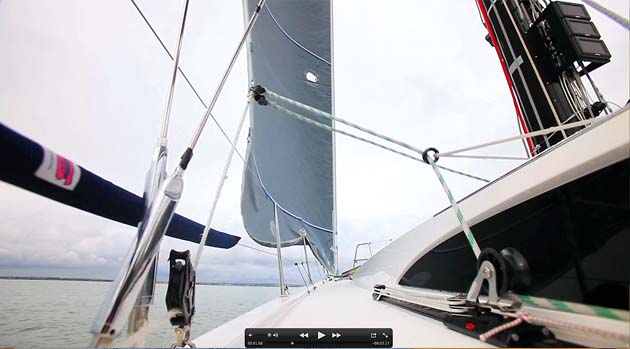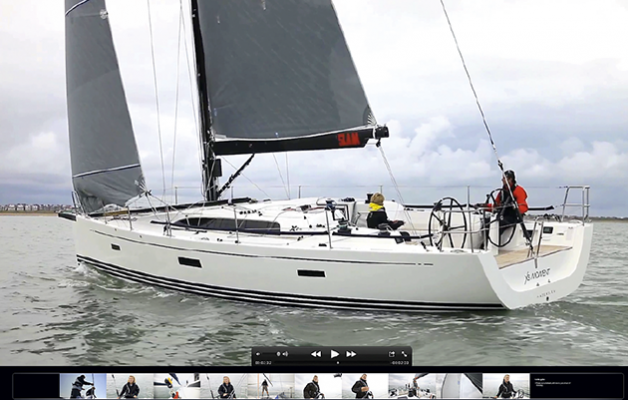Pip Hare outlines the finer points of reaching in moderate or heavy breeze for the sixth in our series
![]()
Reaching is the glory point of sail for many boats; it’s the time we record our best speeds and eat up the miles on long passages.
Setting the boat up to reach well under white sails is about harnessing as much power as possible, yet keeping the steering manageable. I’m going to share with you the methods I use when racing to make a difference to performance in moderate and heavier breezes.
The accompanying video features experienced ocean racer and solo sailor Brian Thompson offering his thoughts on white sail reaching – he spent over 40 per cent of the time on this point of sail during the last Vendée Globe race.
See our video of SAIL FASTER SAIL SAFER Part 6
Genoa
Easing the headsail sheets when reaching can cause you to lose a lot of power from the jib as the head twists away from the wind. Moving the car forward will help control this. However, as you bear away further, closing the top of the sail will lead to the bottom being hooked in.
In these conditions an outboard lead will improve your performance enormously, allowing you to trim the sail to an even shape all the way up and this can make a decent impression on boat speed.
Set up a snatchblock on or close to the toerail. Start with it level with the forward position of your jib car. Attach a spare sheet to the clew of the headsail, pass it through the block and then take it back to a winch in the cockpit. This sheet can lead inside or outside the guardrails.
By transferring the load onto the new sheet, you can pull down harder on the leech, powering up the top of the sail without over-sheeting the bottom section. Play around with the fore and aft position of the snatchblock to achieve an even depth all the way up the sail.
The use of a spare sheet as the outboard lead means you can revert to the original sheeting position quickly, or even tack.
Attach outboard sheet lead to headsail clew:

Outboard lead:

Trimming outboard lead:

Mainsail
Bearing away onto a reach and easing the mainsheet alone will allow the boom to lift, creating twist in the top of the main and so depowering it.
By dropping the traveller to leeward you can set the correct angle of attack for the sail without having to release as much mainsheet, keeping the sail powered up. Use the leech telltales as a guide and ease the sheet until they fly 95 per cent of the time.
As you bear away further and the boom nears the quarter, you may find the mainsheet alone will not control twist, so try pulling on the kicker to assist. Watch the top batten in the mainsail and aim to have it parallel with the boom as long as this is not creating excess heel. Easing the outhaul will put a little more depth and so power into the bottom section of the sail, though be careful not to over-ease and decrease your sail area.
Easing the kicker in gusts, when the boat is thrown off course by waves or if it looks as if the end of the boom will dip in the water, should allow the boom to rise up in the air and so help keep control of the steering.
As the wind rises and the angle of heel increases, depower the main to keep in control and reduce the risk of a broach, by easing the mainsheet or taking in a reef.
On longer passages to stop the sail from flogging it is often better to reef the main early, reducing the sail area aloft and so heeling moment, but allowing you to keep the mainsheet sheeted in and the reefed sail powered up.
Sail on heel angle:

Autopilot
Reaching is one of the conditions where your autopilot could be better than you at steering, doggedly following the given course and not getting distracted by the surrounding environment.
To make life easy on batteries balance the sail plan well, remembering that pilots react to a change in heading, they do not pre-empt waves or gusts, so often it is better to take some of the power out of the main by easing the sheet or reefing, so reducing the tendency of the boat to round up.
Many modern pilots have settings that will allow you to compensate for a cross swell and stop the boat from weaving back and forth as it is thrown off course. This is known as counter rudder and in confused seas increasing this setting can make for a smoother ride and allow you to turn down the pilot’s response level, so reducing drain on your batteries.
See our survey of autopilots tested across the Atlantic HERE
Top tips
- Allow the angle of heel to dictate the power in your mainsail – often putting in a reef will increase your speed. An inclinometer will help to gauge this.
- Make sure any attachment points for snatchblocks are well secured from underneath. Put in an extra plate to take the load if you are unsure.
- Watch out for chafe on the genoa, particularly where the guardrails attach to the pulpit. Covering this area of the rail in leather or tape should help.
- If your pilot is steering well, record the settings and conditions in your logbook, so you can replicate them without experimentation another time.
 Single-handed ocean sailor Pip Hare has clocked up thousands of miles racing and cruising. Among her achievements are five solo transatlantics, including the OSTAR and two Mini Transat races. She also works full-time for the RNLI on sea safety and is Consulting Editor on Yachting World. See also her series on short-handed sailing
Single-handed ocean sailor Pip Hare has clocked up thousands of miles racing and cruising. Among her achievements are five solo transatlantics, including the OSTAR and two Mini Transat races. She also works full-time for the RNLI on sea safety and is Consulting Editor on Yachting World. See also her series on short-handed sailing

Photo: Thierry Martinez
Brian Thompson is a vastly experienced sailor, who has raced solo and fully crewed round the world in monohulls and multihulls. His most recent record-breaking run was with Loïck Peyon aboard the trimaran Banque Populaire V, which sailed round the world in a breathtaking 43 days
SAIL FASTER SAIL SAFER Part 7: Pip Hare looks at the tricks that will help keep you moving in the most frustrating of all conditions – light airs
12 part series in association with Pantaenius




